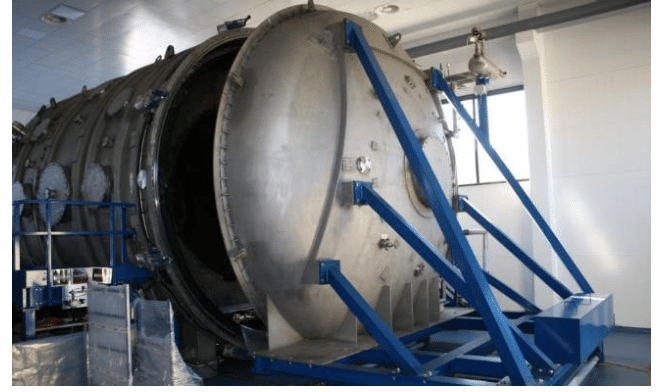Compact electric thruster cleared for space firing
An innovative compact electric propulsion system has recently completed its extended qualification firing test campaign in space-representative vacuum and temperature conditions, leaving it ready to be deployed aboard the ESA-supported µHETSat technology demonstration microsatellite mission, slated for launch by the end of this year.

Developed by Sitael in Italy, the HT100 low power electric propulsion system is centered on a small size and low power Hall Effect Thruster, capable of boosting up to 6 millinewtons of thrust by accelerating ionised propellant particles through a magnetic field. Due to their high efficiency, Hall Effect Thrusters are in widespread use aboard geostationary and low-Earth orbit satellites for orbit maintenance purposes, increasing mission lifetimes, and enabling formation flying for constellations.
“Electric thrusters are highly complex systems on their own, involving almost just about every discipline one can imagine, and it took the team something like a year and a half to optimise the design.” comments Stefano Santandrea, Head of ESA’s Small Satellite Platform Unit, supporting µHETSat.

“The successful completion of this unit’s qualification, of which this test is only the last element, represents a major milestone for all of us. This qualification gives the project confidence that the thruster is getting ready to fly, first on the µHETSat demonstration mission, as well as on several other missions – variously ESA and nationally supported – that will make use of the same thruster technology.”
Testing took place in a 6 x 13 m wide thermal vacuum chamber at Sitael’s premises and test facilities in Pisa, capable of reaching a vacuum level equivalent to ten billionths of the ambient pressure on Earth’s surface.

“The more representative of space we can get the better, since a deviation from the actual environmental parameters foreseen in space can greatly impact the thruster’s behaviour and performance” adds Lucio Torre, responsible for the development and qualification of the propulsion system at Sitael. " All of us in the team are eager to see our thruster operating in space, after its thorough qualification within our vacuum chambers."
The HT100 engine system runs on xenon propellant, whose flow from a spherical high-pressure tank where it is maintained in supercritical state, to its soda-can-sized thruster is regulated by a ‘Propellant Management Assembly’., Meanwhile its ‘Power Processing Unit’ provides and handles the necessary voltages and currents to ionise and properly accelerate the propellant exhaust.

The approximately 70 kg µHETSat satellite used for this in-orbit demonstration– whose platform, also fully developed by Sitael, is an upgraded and rugged version of the one previously used for the ESA’s European Student Earth Orbiter mission – will have the thruster raise and lower its orbit in a series of dedicated tests and in-orbit functional and performance verification campaigns over a planned two-year lifespan. Starting from an initial 550 km altitude orbit, the goal is to achieve at least 1 000 ignition cycles and a single ignition to surpass 600 seconds.
The mission is being supported through the Fly element of ESA’s General Support Technology Programme, aimed at giving early in-orbit demonstration opportunities to promising new European technologies.















 Germany
Germany
 Austria
Austria
 Belgium
Belgium
 Denmark
Denmark
 Spain
Spain
 Estonia
Estonia
 Finland
Finland
 France
France
 Greece
Greece
 Hungary
Hungary
 Ireland
Ireland
 Italy
Italy
 Luxembourg
Luxembourg
 Norway
Norway
 The Netherlands
The Netherlands
 Poland
Poland
 Portugal
Portugal
 Czechia
Czechia
 Romania
Romania
 United Kingdom
United Kingdom
 Slovenia
Slovenia
 Sweden
Sweden
 Switzerland
Switzerland


























